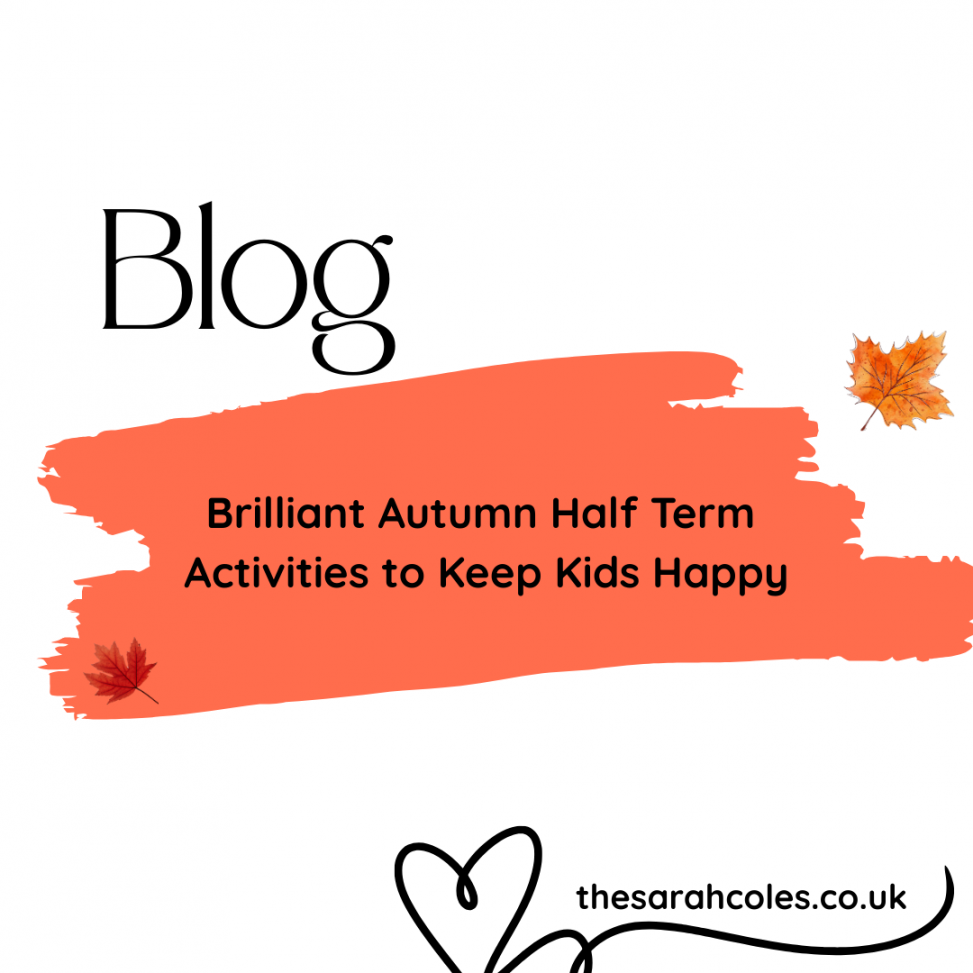The leaves are turning golden, the air is crisp and autumn half term is just around the corner. If you’re wondering how to keep your children entertained for a whole week without breaking the bank or relying on screens, you’ve come to the right place.
Half term holidays can feel overwhelming for parents. You want to create memorable experiences for your kids while managing practical concerns like budget, weather and energy levels. The good news is that autumn offers some of the most exciting opportunities for family fun, whether you’re exploring the great outdoors or creating cosy indoor adventures.
This guide will give you ten fantastic activity ideas that make the most of the season. Each suggestion includes practical tips to help you plan successfully, so you can focus on enjoying quality time with your children. From nature treasure hunts to kitchen science experiments, these activities will keep your little ones engaged, learning and happy throughout the break.
Outdoor Adventures for Autumn Explorers
1. Create a Nature Treasure Hunt
Autumn transforms your local area into a natural playground filled with colourful leaves, interesting seeds, and seasonal treasures. Design a simple treasure hunt by making a list of items for your children to find during a walk.
Include items like:
- A red leaf
- An acorn
- A smooth pebble
- Something that makes a crunching sound
- A feather
- Bark with interesting patterns
You can adapt the difficulty level based on your children’s ages. Younger children might look for colours and shapes, while older kids can search for specific tree species or learn to identify different types of seeds and nuts.
Pack a small bag or container for collecting treasures, and remember to only take items that have naturally fallen to the ground. This activity works brilliantly in parks, woods or even your local streets.
2. Build the Ultimate Leaf Fort
Those piles of autumn leaves aren’t just for jumping in—though that’s definitely encouraged too! Help your children build an impressive leaf fort in your garden or a local park.
Start by gathering large amounts of fan leaves. You can use garden furniture, branches, or even a washing line as a framework. Show your kids how to pile leaves high around the structure, creating walls and even a roof if you’re feeling ambitious.
This activity combines physical exercise with creative problem-solving. Children learn about structure and engineering while getting plenty of fresh air. Plus, the finished fort becomes a cosy hideaway for storytelling, snacks, or quiet reading time.
3. Go on a Conker Championship Quest
Conker collecting is a time-honoured autumn tradition that never gets old. Head to your local park or woodland area to search for the biggest, shiniest horse chestnuts you can find.
Once you’ve gathered your collection, you can try traditional conker games or get creative with crafts. Younger children might enjoy simply sorting conkers by size or using them for counting practice. Older kids can learn the rules of traditional conker battles or use their finds for art projects.
Remember to check that conker collecting is allowed in your chosen location, and always supervise young children around trees.
4. Start a Mini Weather Station
Autumn weather changes frequently, making it the perfect time to become amateur meteorologists. Help your children set up a simple weather monitoring station in your garden or on a windowsill.
You can create basic weather instruments using household items:
- A rain gauge from a clear plastic bottle
- A wind direction indicator using a straw and paper arrow
- A simple barometer with a balloon and glass jar
Encourage your kids to record daily observations in a weather diary. They can note temperature, rainfall, wind direction, and cloud types. This activity builds scientific thinking skills while helping children understand the natural world around them.
5. Organise a Pumpkin Competition
If you have garden space, October is perfect for examining any pumpkins you might have grown during the summer. If you didn’t grow your own, visit a local pumpkin patch or farm shop to choose the perfect specimens.
Use your pumpkins for multiple activities throughout the week. Start with measuring and weighing to practice maths skills, then move on to carving or decorating. Don’t forget to save the seeds for roasting—a delicious and healthy snack that children love helping to prepare.
The pumpkin flesh can become soup, pie, or bread, turning your activity into a cooking adventure that teaches children about reducing food waste.
Indoor Fun for Cosy Days
6. Set Up a Kitchen Science Laboratory
Transform your kitchen into an exciting science laboratory using everyday ingredients. Autumn is perfect for experiments that mirror the season’s natural processes.
Try these simple experiments:
- Leaf colour extraction: Use autumn leaves, hot water, and coffee filters to separate the different pigments in leaves
- Apple oxidation investigation: Compare how different liquids (lemon juice, water, salt water) affect apple browning
- Seed germination observation: Plant different seeds in clear containers to watch roots and shoots develop
Each experiment teaches scientific principles while keeping children engaged through hands-on discovery. Provide notebooks for recording observations and predictions, encouraging your budding scientists to think like real researchers.
7. Create an Autumn Art Gallery
Gather those beautiful leaves, acorns, and other natural treasures from your outdoor adventures and transform them into stunning artwork. Set up different art stations around your home, each focusing on a different technique.
Station ideas include:
- Leaf printing: Use paint and leaves to create beautiful prints on paper
- Nature collages: Arrange natural materials into pictures and patterns
- Autumn sun catchers: Press leaves between contact paper to create window decorations
- Seed mosaics: Use different seeds and grains to create textured pictures
This activity develops fine motor skills, creativity, and artistic expression. Display the finished artworks around your home to create a seasonal gallery that celebrates your children’s creativity.
8. Build an Indoor Obstacle Course
Rainy days don’t have to mean restless children. Use furniture, cushions, and household items to create an exciting indoor obstacle course that challenges both body and mind.
Design different stations that test various skills:
- Crawling under tables
- Jumping between cushions
- Balancing along a tape line
- Throwing soft balls into baskets
- Completing puzzles at checkpoints
Time your children as they complete the course, encouraging them to beat their personal best rather than competing against siblings. This keeps the focus on individual achievement and maintains positive energy.
9. Host a Storytelling Marathon
Create a cosy reading corner with blankets, cushions, and soft lighting. Dedicate an afternoon or evening to storytelling, mixing reading aloud with creative story creation.
Start with autumn-themed books that capture the season’s magic. Then encourage your children to create their own stories using seasonal props like leaves, acorns, and small toys as inspiration.
You can take turns adding to a group story, with each person contributing a sentence or paragraph. This builds language skills, creativity and confidence in self-expression. Record these collaborative stories to preserve the memories and perhaps create a family story collection.
10. Master the Art of Autumn Baking
The kitchen becomes a warm, inviting classroom when you’re baking seasonal treats together. Choose recipes that celebrate autumn flavours and allow children to take active roles in preparation.
Perfect autumn baking projects include:
- Apple crumble: Children can peel apples (with supervision) and mix the crumble topping
- Pumpkin muffins: Let kids measure ingredients and learn about fractions
- Gingerbread: Rolling, cutting, and decorating develops fine motor skills
- Bread rolls: Kneading dough is excellent sensory play and teaches patience
Baking teaches mathematical concepts through measuring, introduces scientific principles through chemical reactions, and creates delicious rewards for hard work. The whole house will smell wonderful, creating positive associations with cooking and family time.
Making the Most of Your Half Term Break
These activities provide a solid foundation for an engaging autumn half term, but remember that the best family time often comes from being flexible and following your children’s interests. If they’re fascinated by a particular leaf or excited about a cooking experiment that didn’t go as planned, lean into their curiosity.
The key to successful family activities lies in preparation without over-planning. Gather materials in advance, but be ready to adapt based on weather, energy levels, and changing interests. Most importantly, participate alongside your children rather than just supervising. Your enthusiasm and engagement will make every activity more meaningful and memorable.
Autumn half term offers precious opportunities to slow down, explore and create lasting memories together. Whether you’re crunching through leaves on a nature walk or laughing over a kitchen science experiment gone wonderfully wrong, these shared experiences become the foundation of happy childhood memories that will last a lifetime.
Further Reading: Meteorological Autumn: What September Brings to Britain






